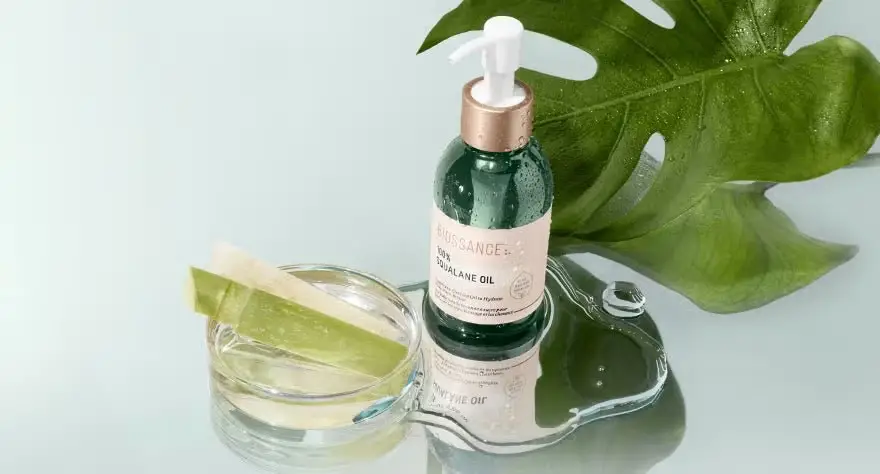
Squalene vs. Squalane: Which Is Better for Your Skin?
The skincare world can be a maze, especially when it comes to ingredients that sound so similar yet serve different functions. Take squalene and squalane, for example.
These two names are easy to mix up, but understanding their differences can help you make better choices for your skin. Let’s break down each ingredient, how they work, and which one might be best for you!
Is Squalane the Same as Squalene?
At first glance, squalene and squalane may seem like the same thing. They share a similar name, but their properties and uses are distinct. Here’s the main breakdown:
Squalene
Naturally Occurring: Squalene is a lipid (fat molecule) produced naturally in the skin’s sebaceous glands, helping to maintain the skin’s oil balance and barrier.
It plays a key role in producing sebum, the natural oil that keeps the skin moisturized.
Antioxidant Power: It is a natural antioxidant, protecting the skin barrier against free radicals caused by pollution, UV rays, and environmental damage.
It also helps with skin’s repair and reducing the appearance of fine lines and sun damage.
Stability Issues: While squalene has great skin benefits, it’s unstable when exposed to air and light.
This means it has a shorter shelf life, so it needs to be stabilized to be used effectively in skincare products.
Squalane
Hydrogenated Version of Squalene: Squalane is derived from squalene through a process called hydrogenation. This makes it more stable and allows it to have a longer shelf life.
Source: Originally, squalane was extracted from shark livers, but today it’s primarily derived from plant oils like olive oil, rice bran, and sugar cane, making it a more ethical choice.
Skin Benefits: Like squalene, squalane is known for its hydrating and anti-aging properties. It helps to replenish lost moisture, reduce dry patches, and maintain the skin’s natural barrier.
It also works well for reducing fine lines, improving skin texture, and promoting a youthful appearance.
What Does Squalane Do for Your Skin?
Squalane is a highly effective moisturizer that helps balance your skin’s oil production, particularly when your skin’s natural oils are out of balance due to aging, harsh weather, or skin conditions. Some key benefits of squalane include:
Hydration: Squalane helps to lock in moisture by forming a barrier on the skin’s surface without clogging pores.
Improves Skin Tone and Texture: It can help create a smoother, more even skin tone and texture, reducing the appearance of fine lines, wrinkles, and dry patches.
Protects Against Environmental Stressors: Squalane has antioxidant properties that protect your skin from the effects of UV exposure, pollution, and environmental damage.
Supports Skin Barrier Health: By mimicking the skin’s natural oils, squalane supports the health of the skin’s barrier, allowing it to retain moisture and defend against irritants.
Is Squalane Better Than Hyaluronic Acid?
This is a tricky comparison because both squalane and hyaluronic acid are excellent at hydrating the skin, but they work in different ways. Here’s how they compare:
Hyaluronic Acid: A humectant that draws moisture into the skin from the environment.
It helps retain water in the skin, which is especially useful for people with oily skin or those suffering from dehydration. It works best for providing an instant hydration boost and plumping the skin.
Squalane: A moisturizer and emollient, which works to lock in moisture and support the skin barrier.
It’s particularly effective for dry or mature skin, as it helps maintain the skin’s oil balance and hydration levels.
Squalane is great for people who need a little more nourishment to keep their skin soft, hydrated, and healthy.
Which one to choose?
Oily skin: If you have oily or acne-prone skin, you might prefer hyaluronic acid, as it draws moisture without adding extra oils.
Dry skin: For drier or more sensitive skin, squalane can be more beneficial since it helps replenish lost oils and strengthens the skin’s moisture barrier.
The best part is, you can use them together! Applying hyaluronic acid first to hydrate and then following up with squalane to lock in that moisture creates a powerful, balanced hydration routine.
Can I Use Squalane and Vitamin C Together?
Yes! Squalane and Vitamin C are a dynamic duo when it comes to skincare.
Vitamin C is an antioxidant that brightens the skin, reduces dark spots, and helps with collagen production, while squalane keeps your skin hydrated and smooth.
How to Layer: Apply Vitamin C first (usually in the form of a serum), as it helps brighten your skin and treat pigmentation.
Afterward, apply squalane as the last step to lock in moisture and give the skin a smooth, nourished finish.
Why it works: Vitamin C’s brightening effects are enhanced by squalane’s hydration and skin barrier support.
This combination is particularly great for tackling uneven skin tone, dryness, and signs of premature aging.
Does Squalane Go Before or After Moisturizer?
Squalane is usually applied after your serum and before your moisturizer (if you’re using both). Here’s the general order for your skincare routine when using squalane:
Cleanse: Start with a gentle cleanser to remove dirt and makeup.
Tone: Use an exfoliating toner (e.g., AHA or BHA) if needed.
Serum: Apply your targeted treatments, like Vitamin C or niacinamide.
Squalane: Apply a few drops of squalane to seal in hydration and help lock in your serum’s benefits.
Moisturizer: Finish with a moisturizer to add another layer of hydration.
Sunscreen: Don’t forget sunscreen during the day!
If your squalane is part of a moisturizing cream or oil, you can skip the moisturizer or apply it after for an extra dose of hydration.
Which is Better: Squalene or Squalane?
In conclusion, squalane is generally the better option for skincare due to its stability, longer shelf life, and versatility.
It’s great for all skin types, especially dry and sensitive skin, and can be easily incorporated into most routines.
While squalene is a fantastic natural ingredient that your skin produces, its unstable nature makes it difficult to use effectively in skincare products, which is why squalane has become the preferred option.
Squalene is better for your skin in its natural form (produced in your body) but is not as effective when used directly in skincare products.
Squalane is the more stable, effective, and accessible form of the ingredient, ideal for most skincare routines.
So, if you’re looking for an ingredient to hydrate, protect, and nourish your skin, squalane is your go-to choice!


